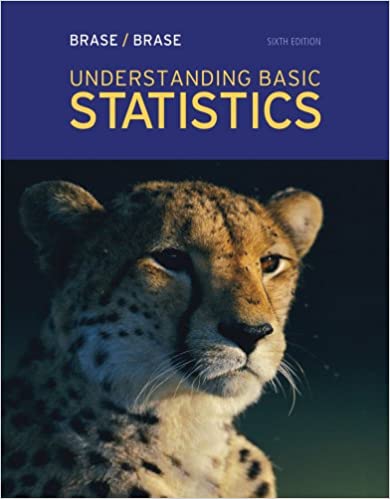
Understanding Basic Statistics 6th Edition by Charles Henry Brase,Corrinne Pellillo Brase
Edition 6ISBN: 978-1111827021
Understanding Basic Statistics 6th Edition by Charles Henry Brase,Corrinne Pellillo Brase
Edition 6ISBN: 978-1111827021 Exercise 28
Please provide the following information for Problems 11-22, part (a):
(i) What is the level of significance State the null and alternate hypotheses.
(ii) Check Requirements What sampling distribution will you use What assumptions are you making What is the value of the sample test statistic
(iii) Find (or estimate) the P -value. Sketch the sampling distribution and show the area corresponding to the P -value.
(iv) Based on your answers in parts (i) - (iii), will you reject or fail to reject the null hypothesis Are the data statistically significant at level a
(v) Interpret your conclusion in the context of the application.
Note: For degrees of freedom d.f. not in the Student's t table, use the closest d.f. that is smaller. In some situations, this choice of d.f. may increase the P -value a small amount, and therefore produce a slightly more "conservative" answer.
Answers may vary due to rounding.
Management: Intimidators and Stressors This problem is based on information regarding productivity in leading Silicon Valley companies (see reference in Problem 21). In large corporations, an "intimidator" is an employee who tries to stop communication, sometimes sabotages others, and, above all, like to listen to him- or herself talk. Let x 1 be a random variable representing productive hours per week lost by peer employees of an intimidator.

A "stressor" is an employee with a hot temper that leads to unproductive tantrums in corporate society. Let x 2 be a random variable representing productive hours per week lost by peer employees of a stressor.

Use a calculator with mean and standard deviation keys to verify that
 , s 1 2.38,
, s 1 2.38,
 , and s 2 2.78.
, and s 2 2.78.
(a) Assuming that the variable x 1 and x 2 are independent, do the data indicate that the population mean time lost due to stressors is greater than the population mean time lost due to intimidators Use a 5% level of significance. (Assume that the population distributions of time lost due to intimidators and time lost due to stressors are each mound-shaped and symmetrical.)
(b) Find a 90% confidence interval for 1 2. Explain the meaning of the confidence interval in the context of the problem.
(i) What is the level of significance State the null and alternate hypotheses.
(ii) Check Requirements What sampling distribution will you use What assumptions are you making What is the value of the sample test statistic
(iii) Find (or estimate) the P -value. Sketch the sampling distribution and show the area corresponding to the P -value.
(iv) Based on your answers in parts (i) - (iii), will you reject or fail to reject the null hypothesis Are the data statistically significant at level a
(v) Interpret your conclusion in the context of the application.
Note: For degrees of freedom d.f. not in the Student's t table, use the closest d.f. that is smaller. In some situations, this choice of d.f. may increase the P -value a small amount, and therefore produce a slightly more "conservative" answer.
Answers may vary due to rounding.
Management: Intimidators and Stressors This problem is based on information regarding productivity in leading Silicon Valley companies (see reference in Problem 21). In large corporations, an "intimidator" is an employee who tries to stop communication, sometimes sabotages others, and, above all, like to listen to him- or herself talk. Let x 1 be a random variable representing productive hours per week lost by peer employees of an intimidator.

A "stressor" is an employee with a hot temper that leads to unproductive tantrums in corporate society. Let x 2 be a random variable representing productive hours per week lost by peer employees of a stressor.

Use a calculator with mean and standard deviation keys to verify that
 , s 1 2.38,
, s 1 2.38,  , and s 2 2.78.
, and s 2 2.78.(a) Assuming that the variable x 1 and x 2 are independent, do the data indicate that the population mean time lost due to stressors is greater than the population mean time lost due to intimidators Use a 5% level of significance. (Assume that the population distributions of time lost due to intimidators and time lost due to stressors are each mound-shaped and symmetrical.)
(b) Find a 90% confidence interval for 1 2. Explain the meaning of the confidence interval in the context of the problem.
Explanation
(a)
Let
and
be the means of the di...
Understanding Basic Statistics 6th Edition by Charles Henry Brase,Corrinne Pellillo Brase
Why don’t you like this exercise?
Other Minimum 8 character and maximum 255 character
Character 255


